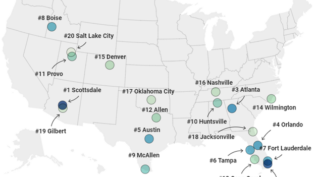
Financial planning is crucial for freelancers, even before they make money. Creating a long-term strategy to help you cover your current costs and reach financial goals sets you up for success.
 One of the top complaints of freelancers is irregular income. Unlike full-time employees, there’s no guarantee that you’ll receive a set amount of income each month. Even experienced freelancers with long-term clients occasionally lose work due to events outside of their control. Fortunately, there are a few things you can do to financially prepare for the challenges that come with a freelancing career.
One of the top complaints of freelancers is irregular income. Unlike full-time employees, there’s no guarantee that you’ll receive a set amount of income each month. Even experienced freelancers with long-term clients occasionally lose work due to events outside of their control. Fortunately, there are a few things you can do to financially prepare for the challenges that come with a freelancing career.
1. Get Ready for Feast or Famine
One of the biggest financial challenges freelancers face is managing inconsistent income. A natural part of the ebb and flow of freelancing is income that goes up and down over time. You may not know how much income you can count on until you’ve been freelancing for a while and have a few long-term clients.
It’s crucial to set aside money during times when you have a lot of work. While it may be tempting to give up on sticking to a budget, even with an inconsistent income, you can rely on a realistic budget to help you feel more financially secure. You can also try online selling by creating a video collage or turn your photos into videos to run a successful online store.
2. Set Aside Time to Manage Money
Freelancing provides you with the ability to be in charge of your time. Even if you intend to work part-time, it may take a while to figure out how to manage your day-to-day task list. While it can be tempting to put off money management tasks in favor of making money, failure to manage your income leads to financial disappointment.
Financial experts recommend setting aside an hour or two each week to take a close look at your budget, plan for future spending and create financial goals. Creating a budget is important, but maintaining it by revisiting your income and spending at regular intervals will help make your budget work for you.
3. Create a Separate Business Account
You may not make a lot of money as a freelancer at first, but it’s crucial to use a separate bank account for your freelancing income and expenses. Not only does it make your life easier when it’s time to file taxes, but having a separate freelancing account and proper invoice tracking makes it simple to track your income.
As your freelancing business grows, having a separate account will allow you to invest in the equipment you may need without feeling like you are creating an extra living expense. Having a separate account for your freelancing income also helps prevent you from spending freelancing income before you set aside money for taxes and other business expenses.
4. Understand Your Living Expenses
Freelancers who grow their side gig into a full-time income may not know when it’s time to quit their full-time day job. One way to make the path clearer is to list your living expenses and understand exactly how much income you need from your freelancing work to replace your salary at your full-time job.
Deciding when to leave your full-time employer depends on your ability to tolerate risk. For the risk-averse, setting aside six months of living expenses can help create a cushion to see you through dips in your income. During these initial months, you can also consider using gift vouchers and discounted e-gift cards to save on day-to-day purchases.
5. Hire a Tax Expert
It may seem premature to hire a tax expert before you start making real money as a freelancer, but the tax code is complicated and ever-changing. Getting the right deductions can help you keep more of your income. When you hire a tax expert early in your freelancing career, you have access to someone who can help you make decisions about your business to optimize your income.
A tax expert can also help you understand the concept of profit vs revenue. Your revenue as a freelancer is the amount of money you bring in before expenses. Profit is what’s left over after you handle business-related expenses, including taxes. It’s crucial to understand the difference and how it applies to your situation so you can create an accurate picture of your future profit.
6. Create Financial Goals
Freelancing can be lucrative, and getting an influx of money is fun but managing it can be difficult. When you give your money a job before it’s in your bank account, you make it work in your favor.
Setting financial goals is different from making a budget. Decide what’s most important to you and give each of your priorities a dollar figure. For example, if paying off high-interest debt is a goal, figure out how much you owe and commit a certain percentage of each of your freelancing paychecks to eliminate that debt.
Another essential thing to remember is that investing in your future financial security is important. Do your research about the best stock investments and the best income funds in which you can put some money aside
Give your goals deadlines of three months, six months, one year, three years and five years. Remember, your goals will change as you gain more experience as a freelancer. You may find that your income goals need to be adjusted. When setting goals, the process is valuable. Financial goals give you a map of your future as a freelancer. It’s OK to change the map as needed.
7. Consider Insurance
Business insurance is a must for many entrepreneurs. Depending on your field and the associated risks, it may make sense to purchase a general liability policy to help cover third-party damages. Professional liability insurance helps cover claims of negligent performance as you provide professional services. Your future clients may require this coverage. These basic policies are generally inexpensive and easy to purchase from reputable insurance companies online. Plus, your business insurance is tax deductible.
For many people, freelancing provides extra income and a path to financial freedom. Nearly half of all freelancers see it as a long-term financial choice, but it only works if you have a plan, such as if you are running any side business.
Regardless of your gig choices, you’ll need a full strategy. For instance, if you start a shipping company, you’ll need to offer packaging with custom cardboard boxes, as well as implement software for load tracking and shipping plans. For your budget, you’ll need to take these supplies and software into account.
With independence and freedom comes tax headaches, variable income, and other various growing pains. Having a plan, hiring experts, and laying out your goals can help put you on the path to freelancing success.
2615 Views











